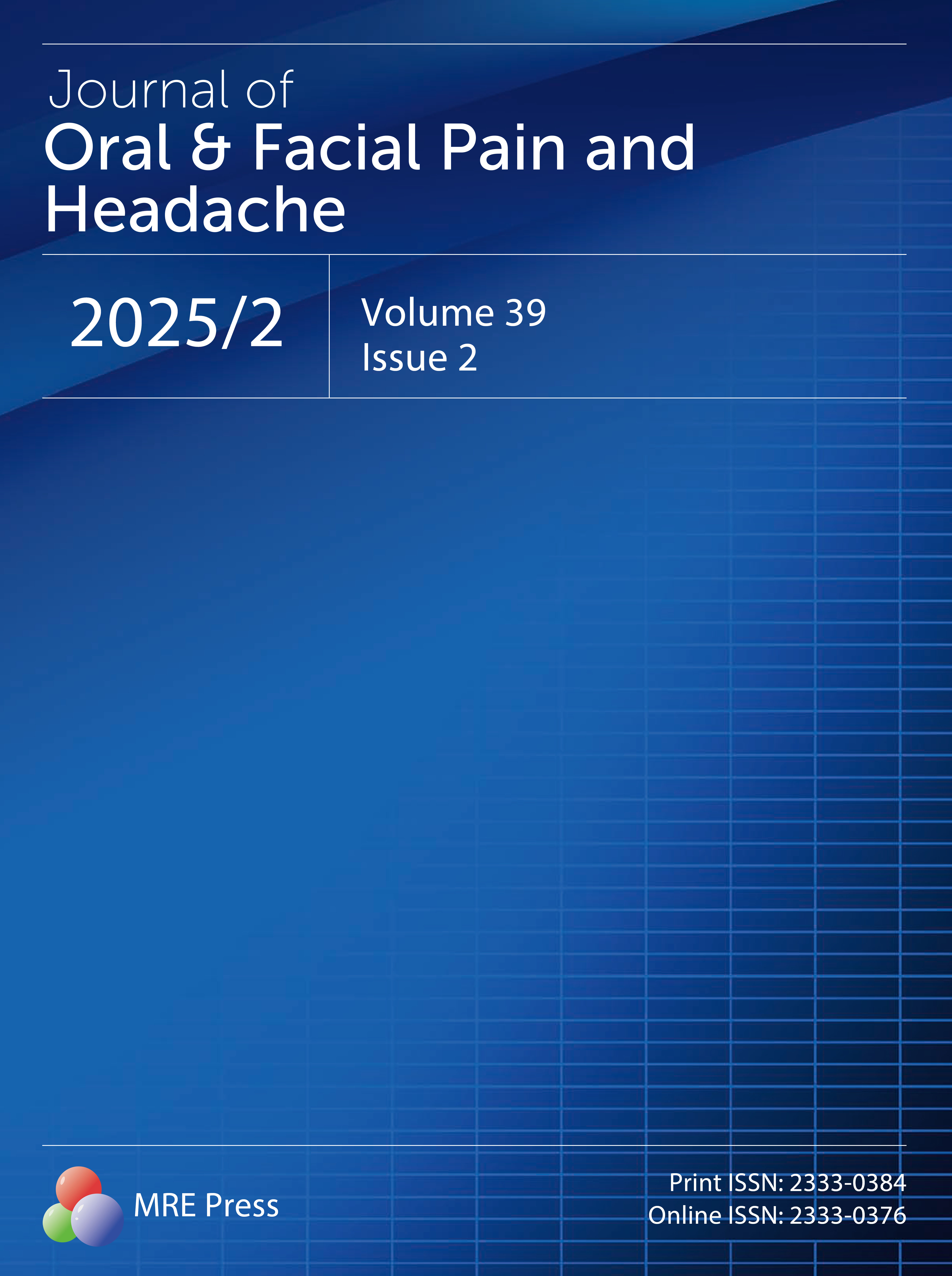Title
Author
DOI
Article Type
Special Issue
Volume
Issue
Article Menu
Export Article
More by Authors Links
Article Data
- Views 864
- Dowloads 25
Journal of Oral & Facial Pain and Headache (OFPH) is published by MRE Press from Volume 38 lssue 1 (2024). Previous articles were published by another publisher on a subscription basis, and they are hosted by MRE Press on www.jofph.com as a courtesy and upon agreement with Journal of Oral & Facial Pain and Headache.
Original Research
Open AccessElongated Styloid Process: An Unusual Cause of Neck Pain and Difficulty in Swallowing
Elongated Styloid Process: An Unusual Cause of Neck Pain and Difficulty in Swallowing
1Opposite MY Hosp, Dept Prosthodont, Govt Coll Dent, Indore 452001, Madhya Pradesh, India
2Shri Aurbindo Inst Dent Sci, Dept Oral & Maxillofacial Surg, Indore, Madhya Pradesh, India
3Govt Coll Dent, Dept Orthodont, Indore, Madhya Pradesh, India
4Inst Dent Studies & Technol, Dept Prosthodont, Modinagar, India
*Corresponding Author(s): Deshraj Jain E-mail: drdeshraijain@rediffmail.com
Abstract
An elongated styloid process is an unusual source of craniofacial and cervical pain. This condition is characterized by a dull, nagging pharyngeal pain and a palpatory finding in the tonsillar fossa. Eagle described it for the first time in 1937 as Eagle’s Syndrome and divided it into two subtypes: the “classic syndrome” and the “stylo-carotid syndrome.” The syndrome generally follows tonsillectomy or trauma. Diagnosis is confirmed by radiological findings. Palpation of the styloid process in the tonsillar fossa and infiltration with anesthetic are also used for making a diagnosis. This article presents a case report of a patient with a history of throat pain that was relieved after surgical treatment.
Keywords
Eagle syndrome;neck pain;styloid process
Cite and Share
Deshraj Jain, Jaideep Singh Chauhan, Sandhya Jain, Gaurav Goel. Elongated Styloid Process: An Unusual Cause of Neck Pain and Difficulty in Swallowing. Journal of Oral & Facial Pain and Headache. 2011. 25(3);269-271.
References
1.Fini G, Gasparini G, Filippini F, Becelli R, Marcotullio D. The long styloid process syndrome or Eagle’s syndrome. J Craniomaxillofac Surg 2000;28:123–127.
2.Guerrier Y, Rabischong P, Guerrier B. Cours Superieur d’anatomie Chirurgicale de Cou et des Glandes Salivaires. Montpellier: Ed Lib Arnett, 1988.
3.Baugh RF, Stocks RM. Eagle’s syndrome: A reappraisal. Ear Nose Throat J 1993;72:341–344.
4.Eagle WW. Elongated styloid process: Symptoms and treatment. AMA Arch Otolaryngol 1958;67:172–176.
5.Mendelsohn AH, Berke GS, Chhetri DK. Heterogeneity in the clinical presentation of Eagle’s syndrome. Otolaryngol Head Neck Surg 2006;134:389–393.
6.Sivers JE, Johnson GK. Diagnosis of Eagle’s syndrome. Oral Surg Oral Med Oral Pathol 1985;59:575–577.
7.Prasad KC, Kamath MP, Reddy KJ, Raju K, Agarwal S. Elongated styloid process (Eagle’s syndrome): A clinical study. J Oral Maxillofac Surg 2002;60:171–175.
8.Chrcanovic Br, custódio aL, de Oliveira Dr. an intraoral surgical approach to the styloid process in Eagle’s syn-drome. Oral Maxillofac Surg 2009;13:145–151.
9.Eagle WW. Elongated styloid process: Further observations and a new syndrome. Arch Otolaryngol 1948;47:630–640.
10.Kaufman SM, Elzay RP, Irish EF. Styloid process variation. Radiologic and clinical study. Arch Otolaryngol 1970;91:460–463.
11.Evans JT, Clairmont AA. The nonsurgical treatment of Eagle’s syndrome. Eye Ear Nose Throat Mon 1976;55:94–95.
12.Loeser L, Caldwell E. Elongated styloid process: A cause of glossopharingeal neuralgia. Arch Otolaryngol 1942;36:198–202.

Abstracted / indexed in
Science Citation Index (SCI)
Science Citation Index Expanded (SCIE)
BIOSIS Previews
Scopus: CiteScore 3.1 (2024)
Cumulative Index to Nursing and Allied Health Literature (CINAHL)
Submission Turnaround Time
Preliminary Review: Typically 1–7 days (median: 5 days)
Peer Review: Typically 4–16 weeks (median: 8.6 weeks)
Notes: Review times may vary depending on manuscript complexity or reviewer availability, with some articles requiring longer than 16 weeks. Your information is kept confidential throughout the review process.
Top
